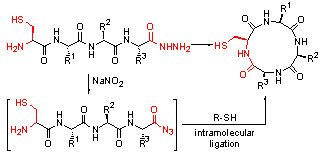| [1] (a) Horton, D. A.; Bourne, G. T.; Smythe, M. L. Chem. Rev. 2003, 103, 893; (b) Rajiv, D.; Hemendra, G. Chin. J. Chem. 2011, 29, 1911; (c) Li, X.; Huang, D.; Sun, L.; Xiu, Z.; Norikazu, N. Chin. J. Org. Chem. 2011, 31, 312 (in Chinese) (李晓晖, 黄大卫, 孙蕾, 修志龙, 西野宪和, 有机化学, 2011, 31, 312.)[2] Kawagishi, H.; Somoto, A.; Kuranari, J.; Kimura, A.; Chiba, S. Tet-rahedron Lett. 1993, 34, 3439. [3] Stahelin, H.; Trippmacher, A. Eur. J. Cancer 1974, 10, 801. [4] De Schepper, S.; Bruwiere, H.; Verhulst, T.; Steller, U.; Andries, L.; Wouters, W.; Janicot, M.; Arts, J.; Van Heusden, J. J. Pharmacol. Exp. Ther. 2003, 304, 881. [5] Kawai, M.; Jasensky, R. D.; Rich, D. H. J. Am. Chem. Soc. 1983, 105, 4456. [6] Kijima, M.; Yoshida, M.; Sugita, K.; Horinouchi, S.; Beppu, T. J. Biol. Chem. 1993, 268, 22429. [7] Kawai, M.; Pottorf, R. S.; Rich, D. H. J. Med. Chem. 1986, 29, 2409. [8] Horton, D. A.; Bourne, G. T.; Coughlan, J.; Kaiser, S. M.; Jacobs, C. M.; Jones, A.; Ruhmann, A.; Turner, J. Y.; Smythe, M. L. Org. Biomol. Chem. 2008, 6, 1386. [9] White, C. J.; Yudin, A. K. Nature Chem. 2011, 3, 509. [10] Schimidt, U.; Langner, J. J. Pept. Res. 1997, 49, 67. [11] Pastuszak, J.; Gardner, J. H.; Singh, J.; Rich, D. H. J. Org. Chem. 1982, 47, 2982. [12] Alcaro, M. C.; Sabatino, G.; Uziel, J.; Chelli, M.; Ginanneschi, M.; Rovero, P.; Papini, A. M. J. Pept. Sci. 2004, 10, 218. [13] Fairweather, K. A.; Sayyadi, N.; Luch, I. J.; Clegg, J. K.; Jolliffe, K. A. Org. Lett. 2010, 12, 3136. [14] Meutermans, W. D. F.; Bourne, G. T.; Golding, S. W.; Horton, D. A.; Campitelli, M. R.; Craik, D.; Scanlon, M.; Smythe, M. L. Org. Lett. 2003, 5, 2711. [15] Haas, K.; Ponikwar, W.; Noth, H.; Beck, W. Angew. Chem. Int. Ed. 1998, 37, 1086. [16] (a) Tai, D. F.; Lin, Y. F. Chem. Commun. 2008, 44, 5598. (b) Lin, Y. F.; Lee, S.-M.; Chen, C.-T.; Lu, K.-H.; Tai, D.-F. J. Chin. Chem. Soc. 2009, 56, 127. [17] (a) Zheng, J.-S.; Chang, H.-N.; Wang, F.-L.; Liu, L. J. Am. Chem. Soc. 2011, 133, 11080; (b) Fang, G.-M.; Li, Y.-M.; Shen, F.; Huang, Y.-C.; Li, J.-B.; Lin, Y.; Cui, H.-K.; Liu, L. Angew. Chem. Int. Ed. 2011, 50, 7645; (c) Shen, F.; Tang, S.; Liu, L. Sci. China Chem. 2011, 54, 110; (d) Zheng, J.-S.; Chang, H.-N.; Shi, J.; Liu, L. Sci. China Chem. 2012, 55, 64; (e) Fang, G.-M.; Cui, H.-K.; Zheng, J.-S.; Liu, L. ChemBioChem 2010, 11, 1061; (f) Zheng, J.-S.; Cui, K.-C.; Fang, G.-M.; Xi, W.-X.; Liu, L. ChemBioChem 2010, 11, 511. [18] Zheng, J.-S.; Tang, S.; Guo, Y.; Chang, H.-N.; Liu, L. ChemBioChem 2012, 13, 542. [19] Yin, W. Q.; Zou, J. M.; She, Z. G.; Vrijmoed, L. L. P.; Jones, E. B. G.; Lin, Y. C. Chin. Chem. Lett. 2005, 16, 219. [20] Zheng, J.-S.; Xi, W.-X.; Wang, F.-L.; Li, J.; Guo, Q.-X. Tetrahedron Lett. 2011, 52, 2655. [21] (a) Crich, D.; Banerjee, A. J. Am. Chem. Soc. 2007, 129, 10064; (b) Haase, C.; Rohde, H.; Seitz, O. Angew. Chem. Int. Ed. 2008, 47, 6807; (c) Chen, J.; Wan, Q.; Yuan, Y.; Zhu, J.; Danishefsky, S. J. Angew. Chem., Int. Ed. 2008, 47, 8521; (d) Yang, R. L.; Pasunooti, K. K.; Li, F. P.; Liu, X. W.; Liu, C. F. J. Am. Chem. Soc. 2009, 131, 13592; (e) Kumar, K. S. A.; Brik, A. J. Pept. Sci. 2010, 16, 524; (f) Harpaz, Z.; Siman, P.; Kumar, K. S. A.; Brik, A. ChemBioChem 2010, 11, 1232; (g) Rohde, H.; Seitz, O. Biopolymers 2010, 94, 551; (h) Shen, F.; Zhang, Z.-P.; Li, J.-B.; Lin, Y.; Liu, L. Org. Lett. 2011, 13, 568; (i) Shang, S.; Tan, Z.; Dong, S.; Danishefsky, S. J. J. Am. Chem. Soc. 2011, 133, 10784; (j) Siman, P.; Karthikeyan, S. V.; Brik, A. Org. Lett. 2012, 14, 1520. |
